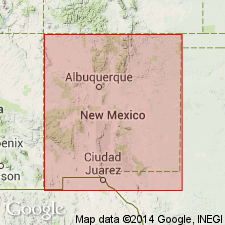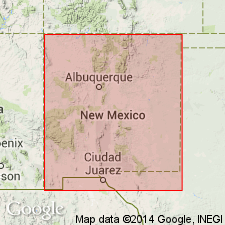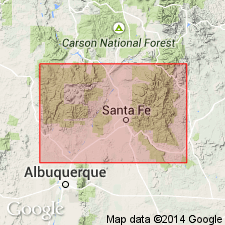
- Usage in publication:
-
- Del Padre Sandstone
- Modifications:
-
- Original reference
- Dominant lithology:
-
- Sandstone
- Conglomerate
- AAPG geologic province:
-
- Las Vegas-Raton basin
- Palo Duro basin
- San Luis basin
Summary:
Pg. 20-25, pl. Del Padre Sandstone. Name proposed for unfossiliferous orthoquartzitic sandstone of undetermined age in Sangre de Cristo area. Unconformably overlies Precambrian igneous or metamorphic rocks. This sandstone was included by Baltz and Read (1960, AAPG Bull., v. 44, no. 11) as lower of four lithologic members of Espiritu Santo Formation. These authors did not describe the sandstone and conglomerates in outcrop areas of its maximum development. Conformably underlies Espiritu Santo Formation and upper part believed to interfinger laterally with Espiritu Santo. At type locality basal contact with Precambrian well exposed but upper contact with Mississippian limestone covered. Thickness 93 feet at type locality. Abnormal thicknesses of quartzitic sandstone assigned to Del Padre occur at three widely separated localities. All are near Picuris-Pecos fault and their anomalous features may be related to it in origin. Sandstone at all three localities underlain by Precambrian quartzite. Thickness 754 feet at Rio Chiquito. Minimum thickness exceeds 200 feet southwest of Pecos Baldy. More than 150 feet north of Rio Pueblo in Osha Canyon. Age undetermined; probably Paleozoic. Report includes geologic map. Present in Mora, Rio Arriba, San Miguel, Taos Counties.
Type locality: bluff on north side of Rito del Padre at its junction with Pecos River, Sangre de Cristo Mountains, [Mora Co.], north-central NM [approx. Lat. 35 deg. 54 min. 30 sec. N., Long. 105 deg. 35 min. 52 sec. W. (from USGS GNIS database and ACME Mapper 2.0, accessed September 28, 2011).]
[Misprint (USGS Bull. 1350, p. 202): junction of Rito del Padre and Pecos River is in Mora Co., not Rio Arriba Co.]
Source: US geologic names lexicon (USGS Bull. 1350, p. 202; supplemental information from GNU records (USGS DDS-6; Denver GNULEX).

- Usage in publication:
-
- Del Padre Sandstone
- Modifications:
-
- Age modified
- AAPG geologic province:
-
- San Juan basin
Summary:
In the section measured at Rio Chiquito--5 mi south of village of Llano and 3 mi southwest of campground on Rio Santa Barbara, Rio Arriba Co, NM, San Juan basin--age of Del Padre Sandstone of Sutherland (1963) modified. Del Padre formerly assigned as of any age from Late Precambrian (post-metamorphic) to Early Mississippian by Sutherland (1963); it is assigned a Pennsylvanian age in this report. Age modification is based on the fact that in Pennsylvanian time, the tectonic setting and marine conditions were conducive to the high-energy, shallow-marine sedimentation typical of Del Padre rocks. Measured sections, correlation charts, fossil lists.
Source: GNU records (USGS DDS-6; Denver GNULEX).

- Usage in publication:
-
- Del Padre Sandstone Member*
- Modifications:
-
- Revised
- Age modified
- AAPG geologic province:
-
- San Juan basin
- Palo Duro basin
- Las Vegas-Raton basin
- Estancia basin
Summary:
Del Padre Sandstone revised--assigned as basal member of Espiritu Santo Formation of Arroyo Penasco Group (raised in rank to group in this report). Del Padre Sandstone Member unconformably overlies Precambrian igneous and metamorphic rocks; underlies carbonate rocks of Espiritu Santo Formation (which are in turn overlain unconformably by Tererro Formation). Del Padre is transgressive and consists of quartz conglomerate, sandstones, siltstones, and thin shale, 0.5-15 m thick; it is overlain by the carbonate rocks of Espiritu Santo (8-26.2 m thick), which contain late Tournaisian microfauna. No microfossils found in Del Padre, and, as suggested by Sutherland (1963) its age may be anything from post-Precambrian to Mississippian. Del Padre interfingers with Espiritu Santo carbonate rocks and should be considered as the basal unit of a normal transgression; thus it is probably late Tournaisian (Osagean, Early Mississippian). Present throughout north-central NM in sections measured in: San Pedro Mountain, Nacimiento and Jemez Mountains (Rio Arriba and Sandoval Cos, San Juan basin, NM); Sandia Mountains (Bernalillo Co, Estancia basin); at Mora Gap (Mora Co, Las Vegas-Raton basin); Coco City (Sangre de Cristo Mountains, Mora Co, Las Vegas-Raton basin); Jack's Creek (Sangre de Cristo Mountains, San Miguel Co, Palo Duro basin); and Tererro (San Miguel Co, Palo Duro basin). Sections, correlation chart.
Source: GNU records (USGS DDS-6; Denver GNULEX).
For more information, please contact Nancy Stamm, Geologic Names Committee Secretary.
Asterisk (*) indicates published by U.S. Geological Survey authors.
"No current usage" (†) implies that a name has been abandoned or has fallen into disuse. Former usage and, if known, replacement name given in parentheses ( ).
Slash (/) indicates name conflicts with nomenclatural guidelines (CSN, 1933; ACSN, 1961, 1970; NACSN, 1983, 2005, 2021). May be explained within brackets ([ ]).

